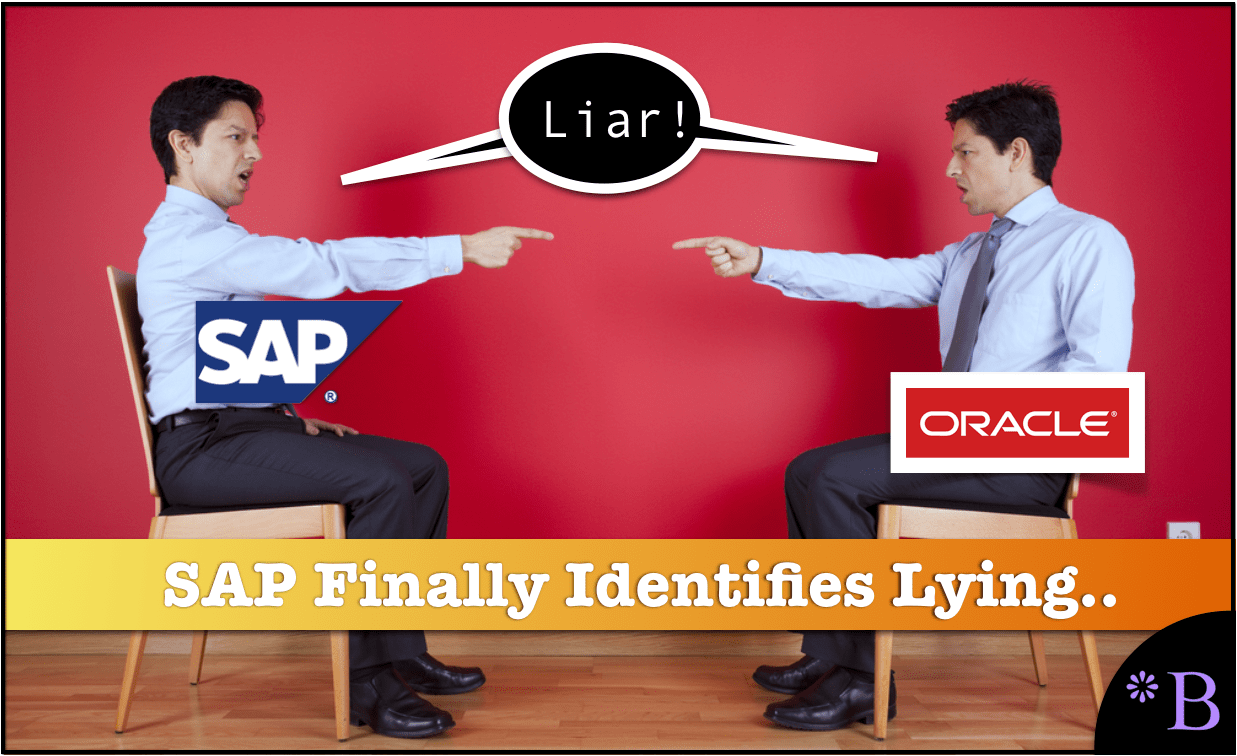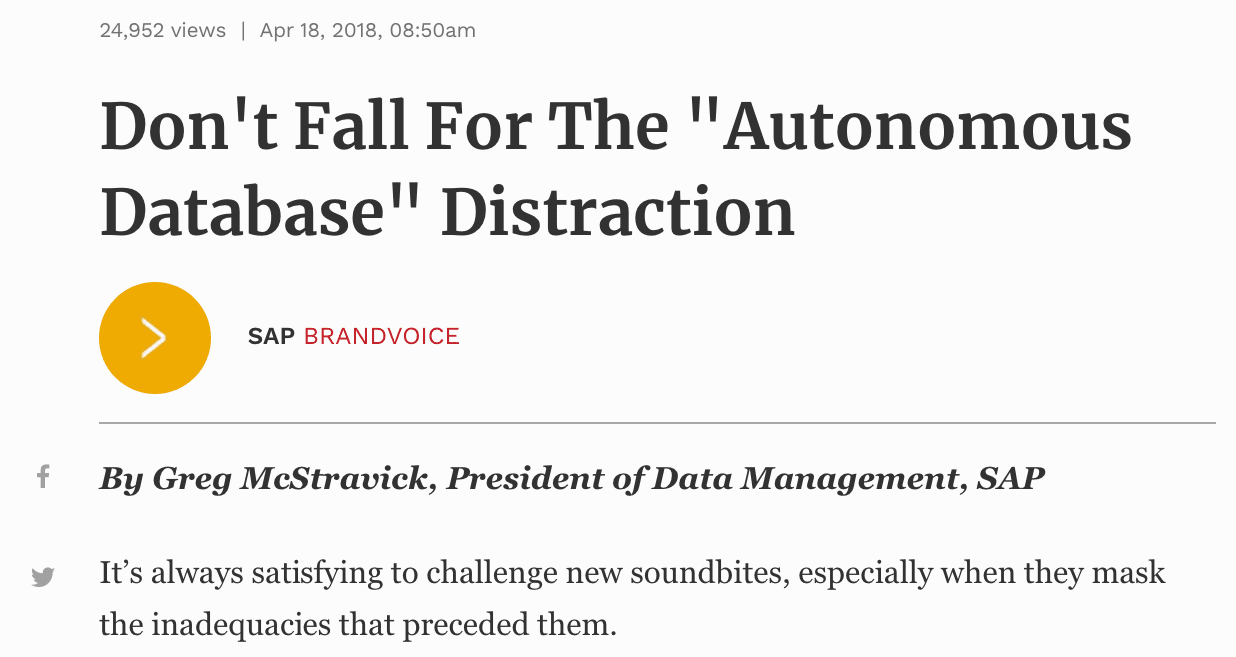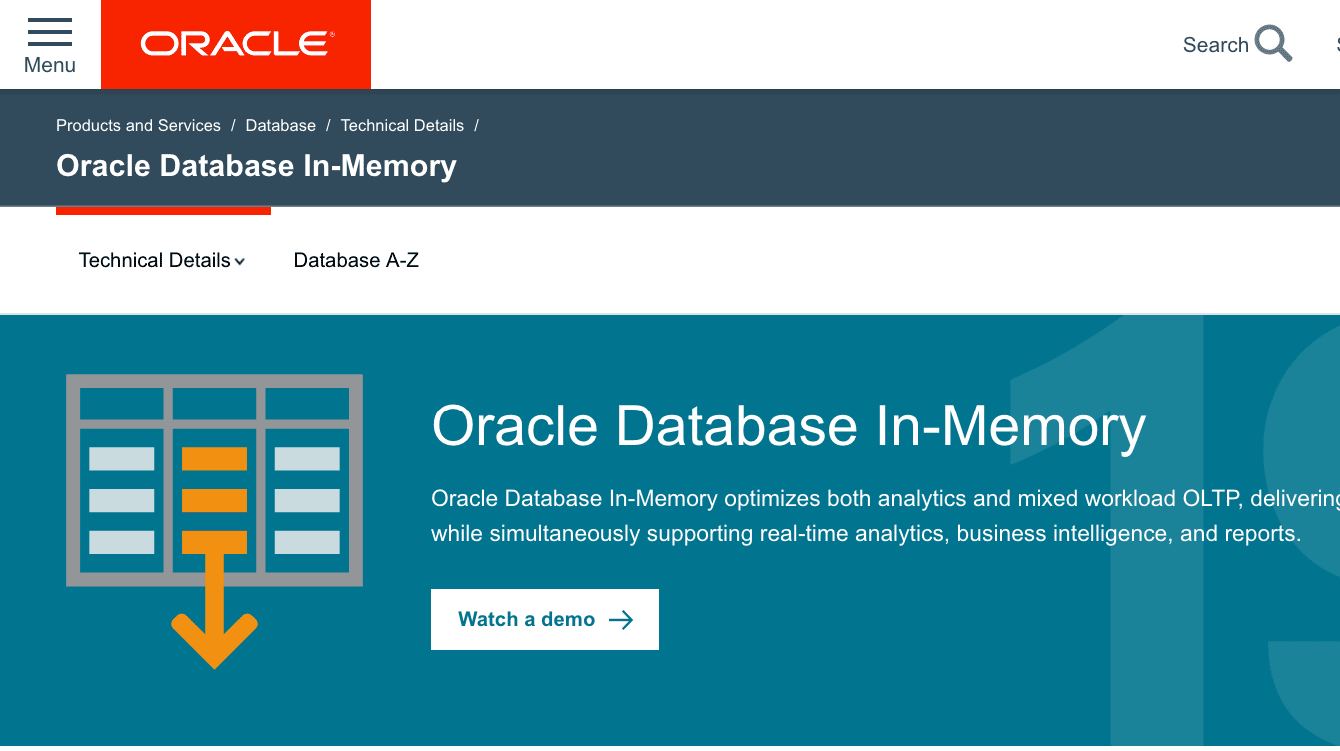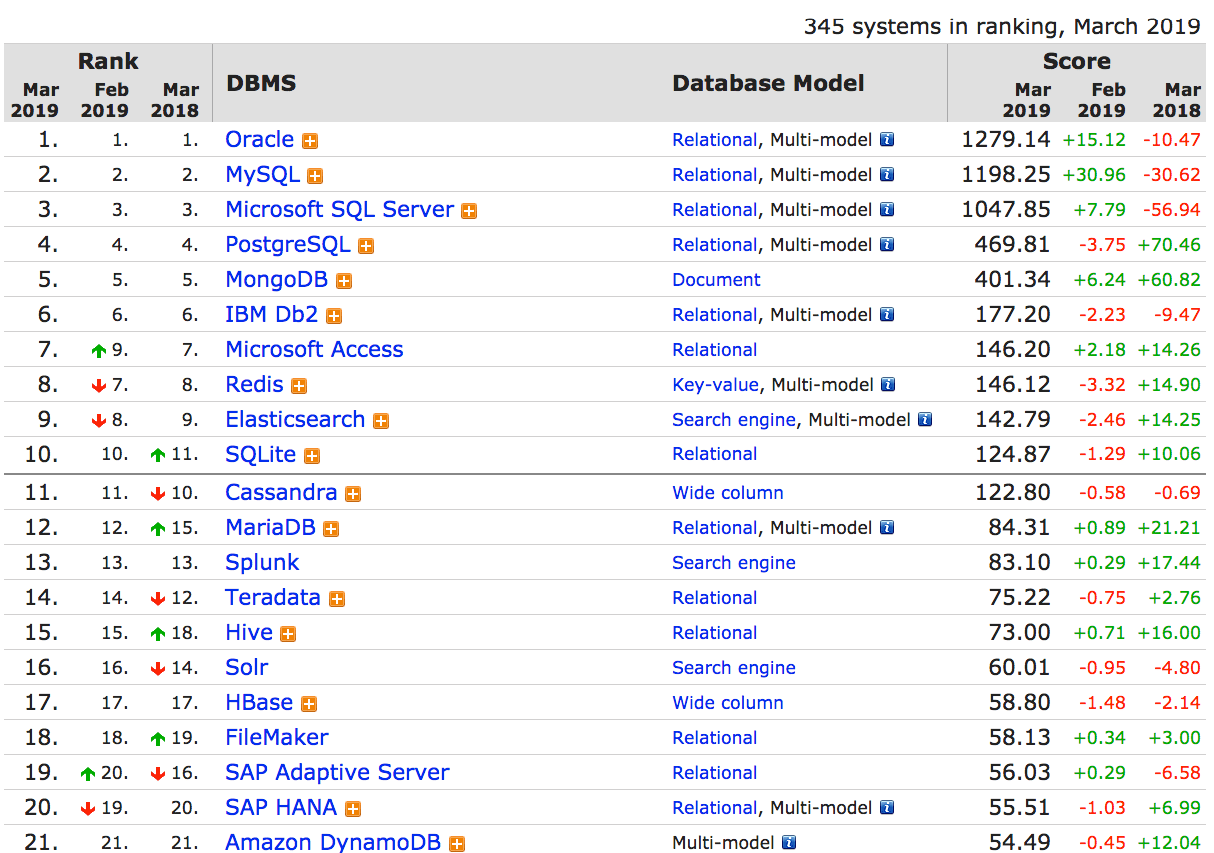Forbes Allows SAP to Vent Against the Oracle Autonomous Database for Money
Executive Summary
- SAP paid Forbes to allow it to run an editorial as if it were an article.
- SAP finally found something it thinks is false: the Oracle autonomous database.

Introduction
SAP has an eight-year history of lying about HANA. And SAP resources take great offense to being called out as lying. In fact, many SAP resources defend lying as exaggerating and proposing that this is “strong marketing.” However, the article written by Greg McStravick of SAP and published in Forbes as a “BrandVoice” that we analyze here demonstrates that SAP can identify when lying is occurring. That is when a competitor performs it.
Our References for This Article
If you want to see our references for this article and other related Brightwork articles, see this link.
Lack of Financial Bias Notice: The vast majority of content available on the Internet about Oracle is marketing fiddle-faddle published by Oracle, Oracle partners, or media entities paid by Oracle to run their marketing on the media website. Each one of these entities tries to hide its financial bias from readers. The article below is very different.
- This is published by a research entity, not some dishonest entity that is part of the Oracle ecosystem.
- Second, no one paid for this article to be written, and it is not pretending to inform you while being rigged to sell you software or consulting services. Unlike nearly every other article you will find from Google on this topic, it has had no input from any company's marketing or sales department. As you are reading this article, consider how rare this is. The vast majority of information on the Internet on Oracle is provided by Oracle, which is filled with false claims and sleazy consulting companies and SAP consultants who will tell any lie for personal benefit. Furthermore, Oracle pays off all IT analysts -- who have the same concern for accuracy as Oracle. Not one of these entities will disclose their pro-Oracle financial bias to their readers.
What is Forbes “Brand Voice?”
Notice the designation of this article, as “SAP Brand Voice.”

“Brand Voice” is apparently the euphemism that Forbes uses for paid content. As funding entities already have advertisements, it is unclear why “brands” require even more representation. However, this what happens when you sell your media entities to Chinese multinationals, as happened to Forbes in 2017.
Articles Quotes
Technology is Important?
“It’s always satisfying to challenge new soundbites, especially when they mask the inadequacies that preceded them. Similarly, it would be easy to believe that big database companies like Oracle are leading the renaissance of their own industry. It just wouldn’t be true. Before we delve into the expected “our technology is better than their technology”debate, let’s remember why the argument itself is worth having. The short answer is because the entire global economy is built on technology. Every consumer served, job created and resource managed relies on the intersection of business and technology.
The slightly longer answer is because we are still playing catch up from the 1990s and early 2000s. During this period, despite obvious signs that data was about to explode in relevance, database technology was void of meaningful innovation. It was a “sticky” high margin business for a few established market leaders in the segment. Businesses were paying a lot for the technology, which was based on 1970s architecture and was ultimately the slowest part of the technology infrastructure in most companies.”
This quote stops being accurate when it moves from “technology is important” to technology was void of meaningful innovation.
It is unclear what exact database type SAP refers to here, but we will assume it is the RDBMS. And database vendors made many improvements to RDMBSs, in fact, they are modern-day marvels almost undifferentiated from magic. They may have been based upon origins from the 1970s, but the column-oriented design, which is the basis of SAP HANA, also goes back to the 1970s.
This leads to another false proposal.
Stagnant Database Innovation Held Back Businesses?
“Why did that matter?
Because businesses were moving too slowly as a result. CEOs were waiting weeks to get binders about their own business performance. Chief Financial Officers were taking weeks to do routine accounting procedures. Marketers and sales leaders, despite increasing online activity from their consumers, were systemically unable to use that information in a secure fashion to better serve their consumers.”
No that should not have been the case. This all depends upon the efficiency of the reporting of that company, but I don’t ever recall any report taking weeks to run. The far bigger problem is that companies can’t use the information they have or the politics within companies rather than a lack of information. Many companies don’t even measure forecast error, which has nothing to do with hardware performance and everything to do with knowledge of what to do and the desire to be held accountable, as we covered in the article A Frank Analysis of Deliberate Sales Forecast Bias. Modern hardware is so powerful that we have been a golden age of data for some time, and most data is analyzed from a flat-file rather than from databases in any case.
Database Products Were All Legacy?
“Data was becoming the new steel (or oil, or fuel, or gold or whatever your preference), but nobody in the database business was doing anything to solve for the serious shortcomings of their legacy products.”
No. Data was and is still just data. And excellent databases have been proliferating to the point where we have a great selection of products, with AWS, GCP, and Digital Ocean making it increasingly easy to bring up many different types of high-quality databases. Databases as web services is something that has occurred more in the past five years. Here SAP uses legacy as a term to smear all database vendors, which we covered in the article How SAP Used and Abused the Term Legacy.
Hasso Plattner and his PhDs Lead a Renaissance?
“That’s why market forces took the database through something of a renaissance. This was initiated not in California conference rooms, but on a small academic campus called the Hasso Plattner Institute in Potsdam, Germany. With the faster pace of innovation, we’re already at another inflection point. Two forces have emerged to guide this new future: the champions of the old status quo or the intellectual forces that disrupted it.”
False.
Our extensive evaluation of this topic has concluded that SAP added nothing to database innovation. SAP acquired two vendors that made up the basis for HANA as we covered in the article Did Hasso Plattner and His Ph.D. Students Invent HANA?
The last sentence in this paragraph is unintelligible, so we won’t address it.
HANA Provides Speed Enhancements?
“It is clear where we should look for a credible perspective.
Size and speed matter: the lessons of the in-memory revolution
The argument was simple enough: if we aspired to a digital economy, we weren’t going to build one without putting data into main memory. From the perspective of business customers who were exhausted by high cost, low value databases, this was a welcome argument as it ultimately enabled a massive reduction in their total cost of operations.
From a computing perspective, the in-memory architecture sparked a fundamental reinvention of data management. It enabled translytical processing, fundamentally simplifying the database design, eliminating data duplication between OLTP and OLAP systems, and minimizing unnecessary data movement and processes.”
Data is always placed into memory. This is how computers work. If you take the memory out your computer (try it) or out of a server, it won’t boot. This is like saying that gasoline is placed into an engine. Yes. This is addressed in the article How to Understand the In-Memory Myth. HANA uses more memory, but information from a number of HANA customers calls into question how well it can utilize this memory, as we covered in the article How HANA Takes 30 to 40 Times the Memory of Other Databases.
The term transytical processing is made up by SAP, and projects something that SAP has not mastered, which is highly efficient dual-mode processing.
HANA did not simplify the database design, HANA greatly increases the complexity and overhead of an RDBMS as we covered in How Much Has HANA Really Been Simplified?
We Should All Listen to Hasso Plattner?
As Hasso Plattner himself has said repeatedly, if you want to understand this transformation, look at the business outcomes more than just the technology arguments.
“CFOs accelerated: Waberer’s International cut month end close by 60%. CIOs accelerated: Farys reduced database size by 7x while increasing live reporting by 50%. COOs accelerated: Kolon reduced data storage by 75% and increased supply chain transactions and reports by up to 205x. There are countless other examples like VMware, which simplified IT infrastructure and centralized seven legacy data warehouses and 15 terabytes of data into one 6 terabyte database.
This explains why analyst firms, like Forrester, now acknowledge the shifting center of gravity in data management. They just this year released the first-ever competitive analysis of translytical databases (note: SAP HANA is the clear leader in this analysis). It’s also why SAP HANA became one of the fastest adopted technologies in the history of the industry, growing at scale to more than 20,000 customers worldwide.”
The problem with this advice is we have repeatedly caught Hasso Plattner lying about business benefits as we covered in the article Hasso Plattner Right on SAP S/4 HANA?
Therefore, we would suggest not listening to Hasso Plattner on business benefits that customers have received, as they probably did not receive them.
As for Forrester acknowledging the rise of translytical there are two important points. First, Forrester does not employ analysts that know enough about databases to write on the topic. Secondly, SAP would be good to mention that they paid Forrester to write up their study on transyltical databases as we covered in How to Understand the Translytical Database, and it is odd that SAP left out this point. It is almost as if SAP would like readers to think that Forrester wrote their paper without prompting or funding from SAP. Isn’t that curious?
Naturally, Forrester rated SAP as the top provider in this new illusionary category of databases…..but only after SAP’s check cleared.
Is Legacy Still Legacy?
“Legacy is still legacy
The impressive track record of the in-memory era has caused a flurry of new marketing activity around “autonomous databases”. Let’s talk about so-called self-running systems.”
Current RDBMSs that HANA replaces like the Oracle RDBMS are not legacy. It is a database that has seen constant improvement since its introduction and is better performing and lower in maintenance than HANA. Secondly, it is not in our view in-memory databases that cause Oracle to introduce the Autonomous Database. It is the fact Oracle has seen customers migrate Oracle databases to AWS, and specifically to AWS’s managed database service or RDS. Another reason that the Autonomous Database is unlikely to respond to HANA is that Oracle has already added dual-mode processing to its RDBMS.

Oracle copied SAP’s marketing around in-memory and has introduced a superior database in dual workload processing to HANA, although as covered in our article How Accurate with Bloor Research on Oracle In-Memory?
There is a question as to whether this capability is worth the extra expense, overhead, and complexity.
Oracle is an Aging Database?
“It’s critical to remember that database industry legacy players are still stuck rationalizing or compensating for the layers of old technology that plague their offerings. To wit, while the idea of “autonomous database” has been in progressive data management roadmaps for years, for some the term itself is just a bandage to cover up for an aging product.
The Oracle database has a lot of negatives, including cost, maintenance overhead and complexity, however, it is not old technology and it is not an aging database.
The term does not “cover-up” that the Oracle database is aging, but rather the issue is that Oracle either on-premises or in Oracle Cloud is far more expensive to maintain than Oracle in the AWS fully managed service. It is difficult to tell whether the author, Greg McStravick, believes what he is writing. Most of the senior members of SAP say ridiculous things about technology all the time, so its hard to tell, and there is a notable allergy to reality among SAP’s executive ranks.
If he does believe what he is writing he is confused as to what the Automated Database is designed to market against. No one (outside of SAP) calls Oracle’s database “legacy” or “dated.” There is nothing to market against in this regard because this is not a widely shared impression.
Oracle and Other Databases Aren’t Innovating?
“This isn’t really innovation; certainly not on the scale of in-memory. Just using the term “autonomous database” doesn’t get rid of the 50% of the legacy database, which even in 2018 is still indexes and aggregates, the cruft of an architecture from the late 1970s.”
Oracle is and has been innovating in its database. And it has in-memory already, as we previously pointed out. It is true that the term autonomous database is meaningless, but not because of the reason offered here. The Oracle Autonomous Database is fake, from top to bottom as we covered in the article How Real is Oracle’s Autonomous Database? However, the fact that Oracle uses an index or aggregates is not evidence of anything. Indexes are used to speed lookups, and aggregates are used as reference tables. No one but SAP thinks that either of these database features is negative. And as for the accusation of aging, HANA’s architecture is also from the late 1990s. Both row-oriented (standard RDBMS) and column-oriented (dual-mode RDBMS) were developed simultaneously.
The automobile designed used by all of us goes back to the 1880s or to 1913, depending upon what automobile you want to count as the first.
- 1808 (first car power by an internal combustion engine)
- 1870 (first gasoline-powered internal combustion engine)
- 1880 (first four-stroke gasoline engine)
- 1885 (first production gasoline-powered car)
- 1913 (first mass-produced car)
Yet no one seems to declare that all of the cars today on the road are “legacy.” Improvements get made along the way, and Oracle is not selling the late 1970s version of its database today. If it did, it would not sell any.
HANA is a Performance Upgrade?
““Autonomous database” doesn’t allow business objects to be simplified from 27 tables to 2 for thousands of enterprise customers at scale, while increasing throughput 8X on the same hardware.”
HANA is not simplified and the claims regarding its performance are false. Data points from the field call into question whether HANA can outperform the vastly less expensive SQL Server. HANA requires more hardware than any other database we track and does less with that hardware as we address in the article What is the Actual HANA Performance?
Only SAP Makes Accurate Proclamations?
“If there’s one overall lesson of the SAP HANA paradigm, it is to look beyond the proclamations from database incumbents for the truly disruptive innovation.”
The logic here is quite fuzzy. What is the “lesson” of HANA. HANA can meet not of the claims that SAP makes for it, except that if far more hardware is used, and HANA is tested in only analytic processing against older versions of competing databases, it can win that comparison. Outside of that everything SAP has stated about HANA is not true. Therefore, the overall lesson of HANA is that SAP can continually make unsubstantiated claims. HANA is not innovative but backward engineered from other databases was we cover in Did SAP Reinvent the Wheel with HANA?
Now SAP Has an Autonomous Database Also????
“The same team that led development and commercialization of in-memory computing with SAP HANA has been architecting for autonomous use, for business decision makers and database administrators. The guiding philosophy is that autonomous use should not be limited to automating the work of a database administrator on a legacy database design. It should be able to recommend potential business scenarios that can be further augmented and automated for maximum operational efficiency and performance without the need for extra effort. Here is where actual business users begin to experience real value.”
Ahhhh….so here SAP is saying that they have a more autonomous database than Oracle’s autonomous database…..which is amusing as Oracle’s AD is fake. So SAP has met Oracles fake AD and raised it to another fake AD. Excellent.
But notice that SAP is saying SAP’s AD is far more forward-looking and “is where actual business users begin to experience real value.”
“That is Not A Knife. This is a Knife” – Crocodile Dundee
“The latest releases of SAP HANA have introduced ease of use for administration including automation of tasks, automated failover, automated recovery and zero downtime maintenance, and semi-automated data aging and load balancing with Active/Active. In addition, the groundwork has already been laid for autonomous database capabilities in SAP HANA via a unified intelligent tooling for both on-premise and cloud deployments SAP is also targeting to include proactive workload management with machine learning and operational insights through analysis of data center metrics.”
Yes, so the bottom line is SAP now claims an autonomous database!
Once a vendor claims that one fake thing is superior to another vendor’s fake thing, we have finally arrived at an Alice in Wonderland situation. This is best expressed in the immortal words of Jefferson Airplane.
One pill makes you larger, and one pill makes you small
And the ones that mother gives you, don’t do anything at allGo ask Alice, when she’s ten feet tall
And if you go chasing rabbits, and you know you’re going to fall
Tell ’em a hookah-smoking caterpillar has given you the callAnd call Alice, when she was just small
>When the men on the chessboard get up and tell you where to go
And you’ve just had some kind of mushroom, and your mind is moving lowGo ask Alice, I think she’ll know……
Customers Should Not Lock Themselves into One Technology?? Or One Vendor??
“Moving beyond soundbites about autonomous databases, let’s come back to the actual business challenges faced by actual businesses.
The reality is that businesses cannot and will not lock themselves into a single technology.”
Wait….what?
SAP has argued for decades that their customers must only use SAP because SAP applications only work best when communicating with other SAP systems. Deloitte Accenture and other SAP consulting firms have spent those same decades dissuading customers from buying non-SAP solutions and locking themselves into a single technology, a single vendor and becoming an “SAP shop.”
Therefore, it is curious to now learn that SAP is actually against this strategy….which would mean SAP customers would have to divest themselves of much of their SAP investments.
Superior Cloud Solutions Exclusively….Diversify by Using SAP’s Uncompetitive Cloud
“As a result, progressive firms are embracing multi-cloud and hybrid-cloud deployment models to support businesses which are desperate to infuse artificial intelligence into business processes, regardless of where the data originates.”
So, using multiple vendors does make sense when SAP has nothing to offer in a software area, which is cloud. In this case, customers should “diversify” into truly bad cloud offerings for the sake of diversification. This is the same argument made by Oracle, which also lacks a competent cloud offering. In fact, Oracle is suing the US government because it thinks it will lose the Pentagon JEDI contract, and now another major software monopolist that promotes using only Oracle has all of a sudden switched to proposing that companies distribute their purchases to multiple vendors. In our view US taxpayers should sue Oracle for Oracle suing the US government to force them into using Oracle’s terrible cloud.
Gartner Says….
“Just as it was not feasible to physically move all data into a central data warehouse 20 years ago, it is not feasible to have all data in one cloud, or just in cloud, or just on-premise. Gartner estimates that, “by 2022, as a result of digital business projects, 75% of enterprise-generated data will be created and processed outside the traditional, centralized data center or cloud- an increase from the less than 10% generated today.”
As a result, to be a so-called “intelligent enterprise”, businesses need a new approach to data where DBMS, Big Data and Data Management technologies should further converge to simplify usage, improve performance/cost, and operate in multi-cloud/hybrid-cloud reality. This must occur while demanding a unified user experience across a multitude of data technologies and cloud/on-premise deployment typologies so that data can be trusted, governed, and connected.”
There is really little reason to listen to Gartner on their predictions; this is because Gartner is inaccurate, and their predictions are more meant to garner attention than to be accurate, as we covered in the article Disregarding Gartner’s Deeper Technology Insights and Predictions.
The second paragraph is unintelligible and seems to be trying to make some claim to insightfulness.
Oracle is More Controlling than SAP?
“For a vendor rooted in the “our way or the high way” mentality of the 1990s, this is impossible to accommodate. For a company like SAP which has already pioneered data management once in the past decade, this is the de facto strategy.”
We would rate SAP as more controlling and more ‘our way or the highway” than Oracle. SAP has its own propriety language, stipulates development environments, stipulates that S/4HANA can only work with HANA, and the list goes on and on. SAP controls as many aspects as is possible on projects, therefore, this quote shows a lack of self-awareness on the part of SAP. Oh, SAP has not pioneered anything in data management in the past decade. They promoted the idea of performing dual model processing in an RDBMS, but have not been able to achieve that goal, and there are a lot of open questions as to how necessary that goal is in the first place.
Legacy Database Market is in a Free Fall?
“Some say that database market is declining. This is a little deceiving. The reality is that the legacy database market is in free fall, in large part because it cannot handle the modern challenges confronting business customers -even when new marketing polish is applied.”
The following is the listing of databases from DB Engines.

Most of the databases on this list are what SAP would classify as legacy. Oracle, SQL Server, PostgreSQL, MySQL are all RDBMSs. Therefore in the SAP echo chamber RDBMS = legacy. Oracle, SQL Server, and MySQL are all seeing year over year declines. (MySQL was purchased by Oracle, and companies have tried to migrate away from MySQL to other open source, alternatives). However, PostgreSQL is seeing an increase. The next database is MongoDB, which is a document database seeing similar growth to PostgreSQL, but SAP offers no document database.
What is being seen in the database market is a decline of proprietary databases versus open source databases. HANA is holding steady or seeing a slight uptick but is not growing very much.
Long story short, the data does not support the proposals made by SAP.
- How is the “legacy” database market in free fall?
- How is HANA replacing these “free-falling databases?”
- Why does SAP not observe the other multimodal databases in the top 20 of the DB-Engines list and persist in proposing that only SAP has figured out the multimodal design?
The falsehoods being proposed here are a Rubix Cube of inaccuracy, with a false contention layered on top of another false contention.
“Legacy” Databases are All Marketing Polish?
PostgreSQL and MariaDB have meager marketing budgets as they are open source projects. And unlike SAP, PostgreSQL and MariaDB foundations are honest about what their databases do. Is their growth due to non-existent marketing polish?” One again, none of the contentions are born out by the data, so it is a good thing that Greg McStravick does not rely upon any, as it would entirely undermine his case.
“Legacy” Databases Won’t Help Companies?
“Data management, on the other hand, is a growth and innovation-led market opportunity. It would be difficult to find an executive in any company in any industry who does not have inherently data-driven innovation on their list of business priorities. Even as legacy databases won’t help them, other technologies and services will. If you want a point of view about true data management innovation, don’t look to the old “leaders”. They are the new “laggards”.”
What is “data management?” SAP is offering a database. That is the topic of this article by Greg McStravick. Greg seems to keep switching between comparing databases.” It’s been working great and used by far more entities than HANA, which is apparently the only non-legacy database. It has a column-oriented capability that is good for analytics, which we cover in the article Why SAP HANA Database and HANA Architecture is a Relational.
However, HANA cannot compete against a dedicated analytical database like MariaDB ColumnStore, which is a far more niche database than standard MariaDB.
HANA is categorized as a multimodel database, which is quite common at this point. Just look at how many databases are categorized this way in DB Engine list above. There are 10, including Oracle. Are all of these databases legacy? If so, why do they offer some of the same multimodel capabilities as HANA. (multi-model might mean row-oriented with JSON format, or row-oriented plus columnar, etc..) And if you want to buy a hardware spec with a lot of memory, you can do this with each of these databases. All of this can be tested right online, but not through the SAP cloud. You have to use a cloud services provider like GCP, AWS Digital Ocean, or others.
Conclusion
SAP paid to write and publish this article, which is utter nonsense. We rate this article’s accuracy as a 0 out of 10—the reason being that someone will know less after reading this article than before reading it. The falsehoods have to be peeled away because there are multiple false statements in single sentence. And Forbes performed no quality checking on this article, allowing it to be published. They verified that SAP’s check cleared.

We normally give a single Golden Pinocchio Award per article, and on a few occasions, we have given two Golden Pinocchios to a single article. This article deserves more than three Golden Pinocchios Awards, but we don’t want to count them all as it would be just too time-consuming. As an article goes, this article should be considered toxic waste.
The article contains two exciting features.
- It shows that SAP does have a problem with lying, but only when lying is performed by a competitor. This undermines the statements by so many SAP consultants that SAP cannot be held accountable because they are prompted to do so by Wall Street, or exaggerations are not lies, or fiddle-faddle is necessary to move product, or the world is now spinning faster, or caveat emptor (all real excuses offered to us by SAP). We now have perhaps one of the clearest cut arguments made by SAP against lying.
- SAP claims to have an automated database that is better than Oracle’s Autonomous Database.